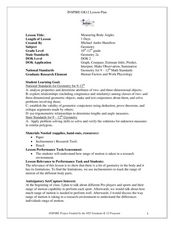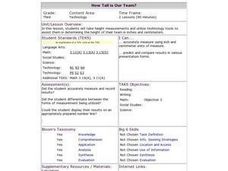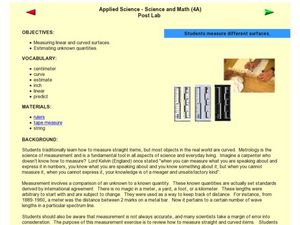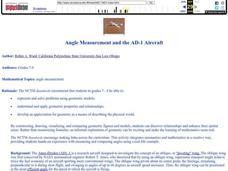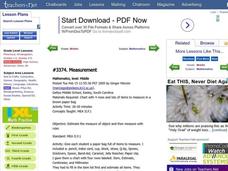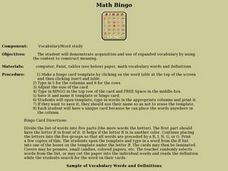Curated OER
Measuring Body Angles
Learners use technology to graph and compare angles. In this geometry lesson, students range of motion in the environment. They identify the missing parts of polygons using similarity and congruence.
Curated OER
Measuring Water Temperature
Learners measure the temperature of three water sources. They collect data points every second for twenty five seconds for each sample using Lego Robolab temperature sensors, complete a worksheet, and analyze the data.
Curated OER
Measuring with My Body
Third graders get into groups of two. Next, give each student a piece of butcher paper that is long enough for them to trace their entire body. One person lies down while their partner traces the outline of their body. Upon completion,...
Curated OER
Measurement Web
Student discuss their prior knowledge of the concept of measurement with class. Then, making a graphic organizer students use educational software to create a web which is then printed off for each student.
Curated OER
Measuring Distance in Cocowalk
Seventh graders select 6 stores and 1 restaurant at Cocowalk and measure the distance of traveling from store to store. They measure the distance from Store 1 to Store 2 and label that distance A.
Curated OER
Making Fudge: Measuring Weight
Fourth graders measure the ingredients for a fudge recipe. In this measurement lesson, 4th graders practice measuring out the ingredients for a recipe to make fudge. Later, students get to enjoy the fudge they made.
Curated OER
Math/Technology: Height Measurement
Third graders, using technology tools, determine the total height of their classmates in both inches and centimeters. Once the measurements are taken, they enter the results in the Excel file. Once students have prepared a KidPix number...
Curated OER
Measurements Around the Classroom
Third graders practice measuring items by examining classroom objects. In this geometry lesson plan, 3rd graders utilize measuring tools to find the weight, time, length or temperature of specific classroom items. Students predict the...
Curated OER
Measuring Different Surfaces
Fourth graders investigate measurement of linear and curved surfaces. In this math lesson plan, 4th graders discuss how to measure curved surfaces and work with a partner to measure various curved surfaces.
Curated OER
Standard Sizes of Paper
Middle schoolers measure the dimensions of different sizes of paper. Using a copy machine, they discover dilations. After enlarging and shrinking particular copies, students examine rates, ratios and percentages and discover the...
Curated OER
Angle Measurement and the AD-1 Aircraft
Students represent and solve problems using geometric models and apply geometric properties and relationships. They also practice constructing and measuring angles. By constructing, drawing, visualizing, and comparing geometric figures...
Curated OER
Measuring Lines to Inch and Centimeter
In this math learning exercise, students practice using metric and standard rulers. Students measure 10 lines in both centimeters and inches. Students write the answers on the lines.
Curated OER
Map Studies - Estimate And Measure Distance
First graders explore estimating and measuring distances. They analyze and discuss a map of New York State, make estimations, measure distances using yarn, and calculate total distances between cities on the map.
Curated OER
Measuring Up!
Young scholars measure body correctly for proper fit, observe how to properly measure body for correct pattern fit, and perform measurements on themselves and partners. Students then alter pattern pieces by adding and shortening lengths.
Curated OER
Conversion of Measurement
Students practice converting measurements using System Internationale (SI). (The metric system is now called System Internationale.) In groups, students measure various objects in the room using the SI system and the standard unit of...
Curated OER
Measurement
Students are given a brown paper sack filled with different types of object for them to measure. They are to first estimate the length and then measure them in centimeters and millimeters.
Curated OER
Math: a World of Symmetry
Learners expand their knowledge of quadrilaterals and identify basic symmetrical forms. Over three weeks, they explore the math, application, and discussion of symmetry. After conducting Internet research, students create symmetrical...
Curated OER
Math Bingo!
Students discover how to change units of measurement by multiplication and division applications. They play math bingo solving multiplication and division problems. Students review their anwers by checking them in class.
Noyce Foundation
Sewing
Sew up your unit on operations with decimals using this assessment task. Young mathematicians use given rules to determine the amount of fabric they need to sew a pair of pants. They must also fill in a partially complete bill for...
Noyce Foundation
Baseball Players
Baseball is all about statistics. Pupils solve problems related to mean, median, and range. They calculate the total weight of players given the mean weight, calculate the mean weight of reserve players given the mean weight of the...
Teach Engineering
About Accuracy and Approximation
How accurate are robots? Groups draw lines by moving robots backwards and forwards by one rotation of the wheels. Using the appropriate formula, they determine the percent error in the length of the lines in relation to the calculated...
Inside Mathematics
Archery
Put the better archer in a box. The performance task has pupils compare the performance of two archers using box-and-whisker plots. The resource includes sample responses that are useful in comparing individuals' work to others.
Inside Mathematics
Rhombuses
Just what does it take to show two rhombuses are similar? The assessment task asks pupils to develop an argument to show that given quadrilaterals are rhombuses. Class members also use their knowledge of similar triangles to show two...
Inside Mathematics
Winning Spinners
Winning a spin game is random chance, right? Pupils create a table to determine the sample space of spinning two spinners. Individuals determine the probability of winning a game and then modify the spinners to increase the probability...


